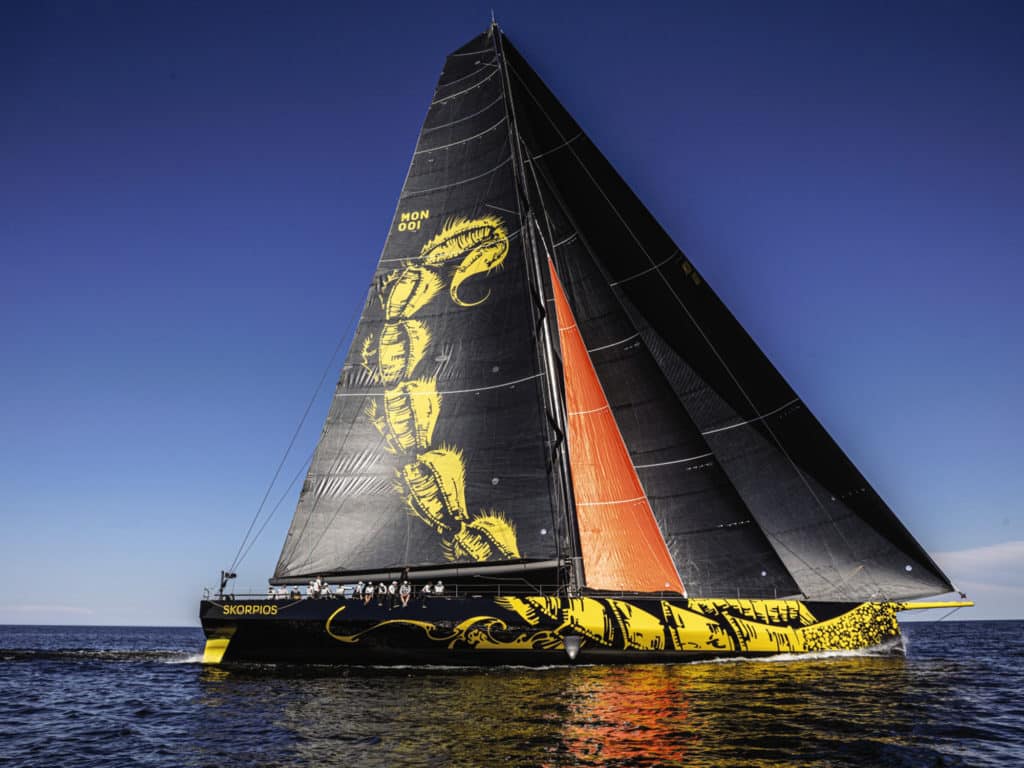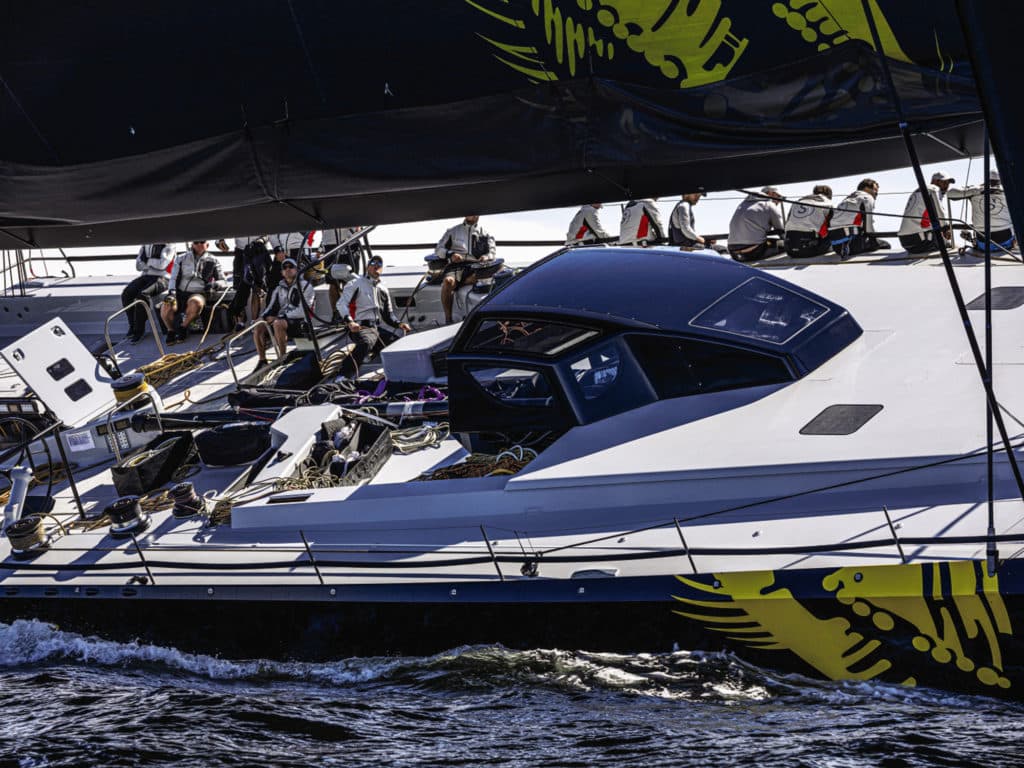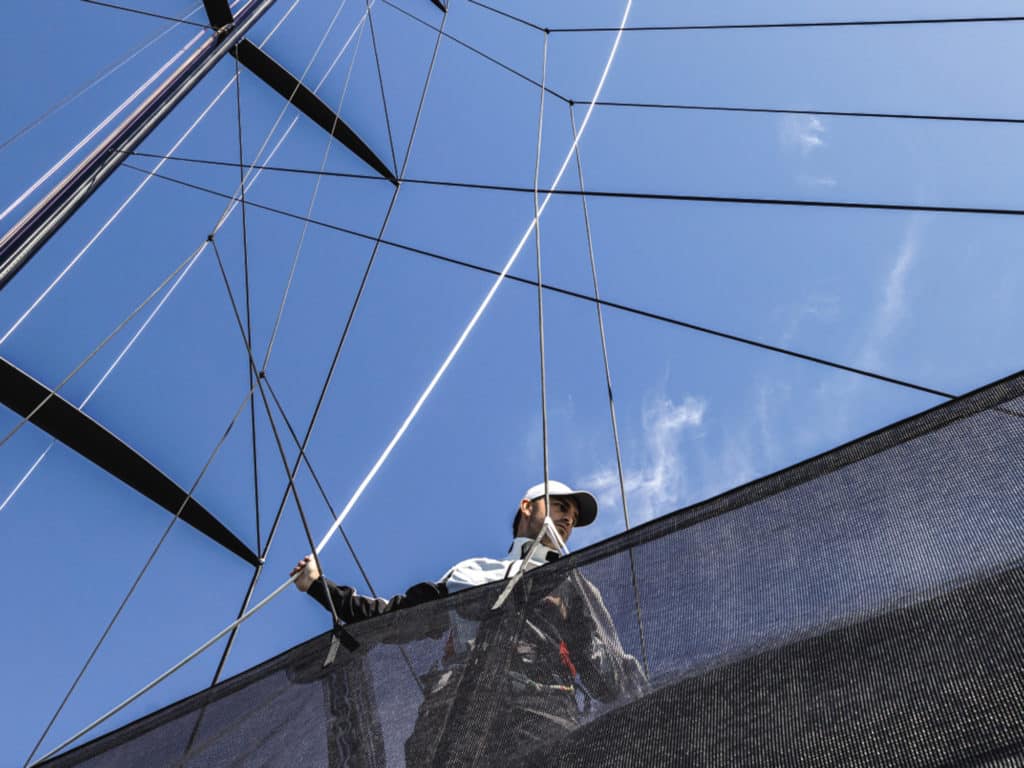
More than four years since work began on the largest-ever creation from Nautor’s Swan, the ClubSwan 125, Skorpios finally launched for its Russian owner, Dmitry Rybolovlev, and by the time you read this, the giant new craft will have competed in its first event, the Rolex Fastnet Race. The Italian-owned Finnish builder claims it to be the fastest monohull ever launched. This was further confirmed when the RORC Rating Office awarded the boat its highest-ever IRC TCC of 2.149.
Seeing the yacht at first glance, aside from the striking yellow scorpion design that extends from its black carbon sails down to the black carbon hull (a trust associated with Rybolovlev owns the Greek island after which the yacht is named), Skorpios resembles an elongated VO70. It feels like one too, from the moment you step on board. It’s lightweight for its size, rocking around in waves unlike a more displaced superyacht. This is less surprising given it was designed by the doyen of the VO70, Juan Kouyoumdjian. However, since then, Juan K. has designed George David’s Rambler 88 and even the ClubSwan 36 one-design, of which both have very different hull forms.
The reason for Skorpios’ relatively conservative shape is because it was originally conceived as a more traditional Nautor’s Swan cruiser/racer. However, since commissioning the design, Rybolovlev has come to enjoy his performance sailing and become better at racing on board his ClubSwan 36 and ClubSwan 50, which culminated in his winning the ClubSwan 50 World Championship in 2019. Thus, Skorpios’ design brief evolved. Its Spanish skipper, Fernando Echavarri, the former Volvo Ocean Race skipper and Olympic Tornado gold medalist, explains: “As he’s sailed the ClubSwan 50 more, he was telling us every time to make this boat go faster and faster. So, then we would have to make an investigation—where is the boat right now? How fast is it now? How fast can we make her if we take another step?”
Because of this progression, Skorpios’ hull shape has a more modest beam-to-length ratio compared to the aircraft-carrier-styled Comanche, and far greater internal volume and higher freeboard. As is the trend these days, special focus was put on the foil and movable ballast package. Skorpios is fitted with twin rudders (with whale-flipper tubercles on their leading edges, as Rambler has) and a substantial keel that can be canted to 42 degrees. The keel is operated by one massive titanium ram on the port side, with a smaller secondary backup ram opposite powerful enough to center the 25-ton bulb and keel foil. In addition, in each aft quarter, there are ballast tanks into which 8 tons of water can be pumped to each side.
Two more unusual aspects of Skorpios’ foil package include the trim tab fitted to its canting keel and the single giant asymmetric, retracting C-foil (something with which Echavarri is familiar, albeit at a much smaller scale, on the Nacra 17 he used to campaign).
The latter resides inside a giant hoop of a case spanning the full breadth and height of the watertight keel compartment midship. Lowered to leeward, the foil prevents leeway and, thanks to its curvature, reduces displacement, but not enough to make Skorpios a flying machine. Downwind, the foil can be fully retracted, leaving roughly 3 feet of tip protruding on each side.
The trim tab is a flap fitted to the back of the keel foil. Conventionally an upwind device, when applied, it gives the foil an asymmetric profile, thereby developing lift and causing the boat to crab to weather. Trim tabs are nothing new, but it’s believed that this is the first time a trim tab has been used on a canting keel, and it remains to be seen if it could reduce righting moment when the keel is canted nearing the horizontal. Given all possible trim variables—plus the additional effect of the water ballast altering heel, and the fore and aft trim of not just the boat but of the foils too —how all of this interacts and can be used to optimal results on different points of sail, boatspeed and wave states will keep Skorpios’ crew and the brain trust behind her occupied for some time.
Echavarri has put together an exceptional crew that includes numerous Volvo Ocean Race and Whitbread heavyweights, such as Kiwi multiple winners Brad Jackson and Tony Mutter, Spanish bowman and Skorpios’ boat captain Pepe Ribes, crew boss Mikey Joubert, navigator Bruno Zirilli, bowman Antonio Cuervas Mons and many others. For the Rolex Fastnet Race, they had 26 on the roster.

On deck, of course, everything is huge. There are some cruising features left over, such as a lounge area aft of the forward companionway, and tiny pit areas to port and starboard, but otherwise it is a pure modern-day racing yacht. The sail plan is colossal. Sloop-rigged, its five-spreader Southern Spars mast (complete with Future Fibres’ low-drag carbon-fiber AeroSix continuous rigging) is 175 feet tall, and its backstays are fitted with substantial deflectors. The boat can carry 11,324 square feet of sail area upwind, and 21,108 square feet downwind. (The mainsail alone is 7,093 square feet, compared to Comanche’s 4,413 square feet.)
Sails are North 3Di, and when we went out in light conditions, given its prodigious speed, the boat seemed to be going faster than the windspeed, even during maneuvers. Its foresails are all on giant furlers, and there are five tack points from the end of the bowsprit for the masthead sails, via the J2 on the forestay, back to the farthest aft for the IRS staysail. Such is the span of the foretriangle that Skorpios might at times fly three headsails simultaneously like the cutters of old.
At the time we were on board in late July, the boat had already undergone sea trials in Finland and been delivered to the UK. The crew was on a steep learning curve trying not to break things, as well as figuring out issues such as how to equate the windspeed and direction at the top of the rig with the significantly different figures at deck level and on the water.
Skorpios’ core area of complexity is its extensive hydraulic systems. This differentiates it from most other Northern Hemisphere offshore maxis, even as recent as Comanche, which were initially launched with manual winch systems (albeit with powered canting keels) to make them eligible for records under World Sailing Speed Record Council rules. However, on Skorpios, everything is hydraulic, with a system designed and built by Cariboni and seeming to comprise almost everything in its catalog. This includes the keel canting system and its many sail and mast/rig controls, all operated by rams or nine hydraulically powered Harken winches. Even for propulsion, the boat has a propeller at the end of a drop-down shaft that is powered by a hydraulic drive.

To make Skorpios more of a racer than superyacht, the boat has been on a huge diet over the course of its build to get it under 66 tons. Its original canting/lifting keel, for example, was dispensed with in favor of its present arrangement, albeit featuring a 24-foot draft.
Ahead of the owner’s accommodations in the center of the boat is a smart but minimalist salon, where there are some tastefully designed pipe berths. Many of the panels here are fabric-covered frames rather than cored panels. Going forward into the front half of the boat, there is a sealed compartment for the C-foil and keel, and then the engine compartment to port, while the bow area is an empty cathedral.
Aft of the owner’s quarters is another unpainted crew area accessed by its own companionway. This houses the nav station, more pipe berths, a crew galley, and a carbon-fiber head and shower compartment, along with large-diameter carbon tubes that run laterally for the water-ballast transfer, and fore and aft for the engine exhaust.
Given that Skorpios was built in the middle of a pandemic and is so fiendishly complex, it is a miracle it was launched at all. A tentative program includes the Rolex Middle Sea Race, and then the boat will go transatlantic for the RORC Caribbean 600. Records have also been mentioned, including west-to-east transatlantic. If all goes well—and by design—this big Swan could very well be the first 700‑mile monohull.









